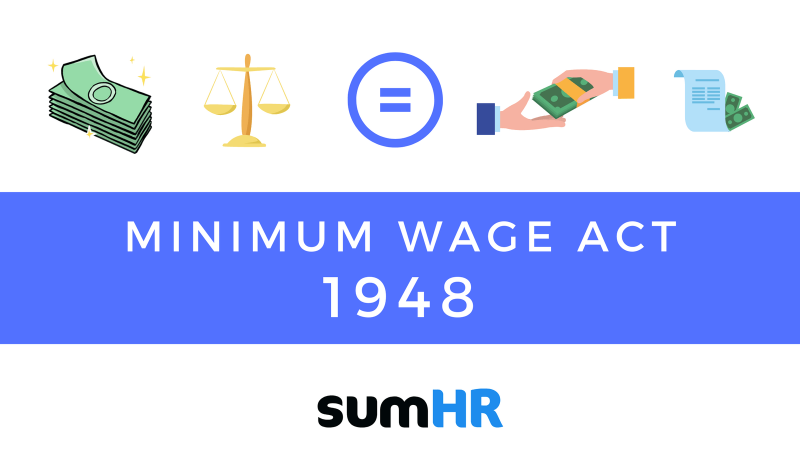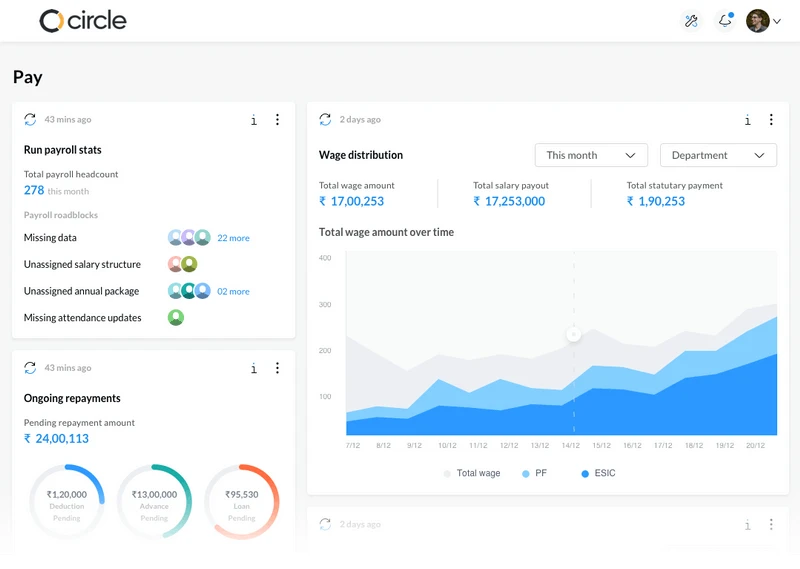Initially passed in 1948, this law is a crucial instrument for guaranteeing that Indian workers receive a fair and decent wage. The Minimum Wages Act establishes the legal minimum wage employers are required to pay their employees, frequently modified to account for changes in the cost of living. In this article, we’ll look at the background and importance of the Minimum Wages Act and how it affects Indian employees and companies.
We will also talk about how crucial the 1948 Pay Act was in defending workers’ rights and ensuring they were given reasonable and fair minimum rates. This blog will offer helpful information and thoughts on this significant subject, whether you are an employee, an employer, or someone interested in labour regulations.
What Is the Minimum Wages Act?
The Minimum Wages Act comes under India’s labour laws that instruct employers to pay their employees a minimum rate wage. The Act applies to both skilled and unskilled workers and is intended to ensure that workers are paid a fair wage that allows them to meet their basic living needs.
The Act requires employers to pay their employees at least the minimum wage rate, which is determined by the government and is based on the cost of living in a particular region. The Minimum Wages Act also provides other special allowances, such as overtime pay and penalties for non-compliance. The Act protects workers’ rights and ensures they are paid a fair wage.
Objectives of the Minimum Wages Act of 1948
The following is a mention of the various goals considered when establishing the Minimum Wages Act of 1948:
- Fixing the basic rate that must be paid to employees (every five years, these rates are updated)
- To ensure that all workers are of sufficient age to maintain a good quality of living
- To make the employees’ regular working hours uniform
- To stop employers from abusing their employees
- To make it possible for workers to take care of their fundamental needs, stay well, and live comfortably
- To punish firms who violate the Act by paying employees less than the set minimum wage
- To level the playing field regarding hours worked and salary for both sexes
Also Read: A guide on Payroll (2023)
Importance of Minimum Wages Act, 1948
The Minimum Wages Act of 1948 is a significant piece of Indian legislation essential for safeguarding employees’ rights and ensuring that they receive reasonable and fair basic rates. Following India’s independence, the Act was initially passed in 1948 to better the lives of the nation’s working population.
1. Establish a Minimum Wage
The Wages Act’s primary goal is to establish minimum basic rates businesses must pay their wage earners. To ensure that workers are given a wage that is enough to cover their requirements and to account for changes in the cost of living, the Act is amended regularly. The Act also covers other perks like overtime pay and fines for non-compliance.
2. Workers Earn Enough to Avoid Poverty
The Wages Act is crucial in ensuring that wage earners are paid enough to maintain a minimal standard of living and prevent poverty. Additionally, it supports a just and fair labour market and helps to improve working conditions for employees. By ensuring that they receive a fair and decent wage, the Act has improved the lives of workers in India. For many workers and their families, it has contributed to an improvement in living standards.
3. Protects Workers from Employer Exploitation
In addition to preventing companies from taking advantage of their employees, one of the Wages Act’s most vital functions is safeguarding workers’ legal protections. The Act protects workers from being underpaid by companies trying to save money by paying their employees less than they are worth. It adds to the development of a more just and equitable labour market in which all individuals involved are accorded the courtesy and respect they deserve.
4. Fair Compensation for Time And Labour
Additional compensation for overtime work and penalties for non-compliance are also included in the Act. It will discourage unscrupulous companies and reward those that pay their employees reasonably for their job.
5. Regular Review and Update
Maintaining the Act’s efficacy requires it to be reviewed and amended regularly to account for inflation and changes in taxation and interest rates. Both employees and employers benefit from a thorough understanding of the law and a collaborative effort to see that it is applied and enforced as intended.
6. Encourages Economic Growth
The Wages Act of 1948 also contributed to economic progress by ensuring that workers were given an adequate wage. By increasing each of these, we may build a more stable and affluent society, which benefits consumers and businesses. The Act also boosts workers’ purchasing power, raising overall demand for goods and services and helping the economy expand.
Also Read: What is HR Software?
Salient Features Of The Minimum Wages Act 1948
- According to the essential provisions of this Act, the minimum hourly rates of wages, minimum piece rate, guaranteed time rate, and overtime pay must be determined for each vocation, each class of work, and each class of worker.
- The cost of living allowance, the introductory rate of pay with or without the cost of living allowance, the cash value of the concessions in respect of necessary items supplied at concessionary rates, or an all-inclusive rate may be included in the minimum rate of earnings under the Act.
- The Act mandates that the distribution of wages be paid in cash. Still, it also gives the competent government the authority to permit the employer to pay the worker’s minimum wage in whole or in part in kind in certain circumstances.
- It specifies that the competent authorities shall compute the cost of living allowance and the monetary value of concessions offered by the employer in respect of deliveries of necessary goods at concessionary rates at such intervals as it considers appropriate. The Director of the Labour Bureau is the appropriate authority for undertakings under the administration of the Union Territories and the Central Government.
- Inspectors and authorities can be appointed under the Act to investigate and rule on complaints about casual workers being paid less than the legally mandated minimum wage, rest day compensation, or overtime pay.
How Is the Minimum Wage Determined in India?
India’s federal and state governments jointly set the minimum wage level. They establish a minimum wage that individual states must meet. On the other hand, states can establish their minimum wages, provided they don’t go below the federal level. There are usually a few procedures involved when establishing a minimum wage:
1. Cost-of-Living Surveys
The government surveys people to ascertain the cost of living in a specific area. The cost of essential products and services, including alternative food wages, shelter, and transportation, is considered in this study.
2. Consultation with Stakeholders
The government interacts with various stakeholders, such as workers’ advocates, business leaders, and economists, to gather opinions on how much a decent minimum wage should be.
3. Determining the Minimum Wage
The government establishes an adequate minimum wage based on the findings of the cost of living survey and the opinions of stakeholders. The government also considers the economy and the ability of businesses to pay the prescribed minimum wage.
4. Notification And Implementation
When the minimum wage is decided, the federal and state governments notify the public and put it into effect. Periodically, the minimum wage is examined and adjusted to reflect the cost of living variations.
Minimum Wages Act, 1948 Constitutionality
Employers have contested the constitutionality of the Minimum Wages Act of 1948 before numerous labour courts. Employers have filed legal complaints alleging that the Act’s provisions are unconstitutional because they impose onerous constraints on the employer.
Due to the Minimum Wages Act’s requirements that employers pay their employees the minimum daily wage, doing so discourages them from continuing their business. It also restricts the employee’s rights because they can only engage in a trade or business once a collective agreement has been reached between them and the employer. As a result, it was argued that the Act broke article 19(1)(g) of the Indian Constitution, which guaranteed freedom of commerce.
However, the court was crucial in ruling that the Act was constitutionally valid and safeguarded the employees’ rights by providing them necessities like food, shelter, clothing, education, and medical care along with a uniform payment of wages. Although the employer may find it challenging to operate a business or launch a new venture in light of certain sections of the Act, these requirements were designed to safeguard the interests of the general public.
Also Read: Maternity leave In India
Wrapping Up
Businesses and workers alike benefit from the Minimum Wage Act of 1948. It makes it easier for workers to support their families and lowers the likelihood of them being financially exploited. Important legislation that significantly improved workers’ lives in India is the Wages Act of 1948. It guarantees workers fair minimum wage rates and provides individual contract agreements against employee exploitation.
The Act is still crucial for advancing workers’ rights and ensuring they receive adequate wages. Employers must be aware of the Act’s requirements and follow them, and both male and female employees must be aware of their wage policies and use them appropriately.
Are you looking for reliable HR automation software to help manage your workforce efficiently? sumHR can be your perfect partner. For more details, visit us!








